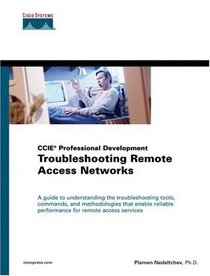Search -
Troubleshooting Remote Access Networks (CCIE Professional Development)
Troubleshooting Remote Access Networks - CCIE Professional Development
Author:
A guide to understanding the troubleshooting tools, commands, and methodologies that enable reliable performance for remote access services
Author:
A guide to understanding the troubleshooting tools, commands, and methodologies that enable reliable performance for remote access services
- Gain a solid grasp of enterprise telecommunications technology fundamentals, including service options and clocking, line coding, and framing in carrier systems
- Understand how network traffic ... more »
- Examine a layer-by-layer, systematic approach to troubleshooting issues
- Design, configure, and troubleshoot T1 and PRI circuits, text and PPP dial-in and dial-out services, and Cisco AS5000 Access Servers
- Design, configure, and troubleshoot ISDN BRI at the physical, data link, and network levels, as well as PPP, MMP, and telephone interfaces
- Design, configure, and troubleshoot Frame Relay UNI and NNI interfaces, with a focus on new installs, wrong DLCI, LMI settings, performance and multicast issues, and re-hosting of Frame Relay service
- Design, configure, and troubleshoot PTPP, L2TP, and IPSec VPNs, examining specific VPN clients, Internet technology, and LAN issues
- Resolve common availability issues for all major remote access technologies through real-world scenarios for dial, ISDN, Frame Relay, and VPNs
ISBN-13: 9781587050763
ISBN-10: 1587050765
Publication Date: 11/11/2002
Pages: 896
Rating: ?
ISBN-10: 1587050765
Publication Date: 11/11/2002
Pages: 896
Rating: ?
0 stars, based on 0 rating
Genres:
- Computers & Technology >> Certification >> Exams >> CCIE
- Computers & Technology >> Certification >> Publisher >> Cisco
- Computers & Technology >> Certification >> Subjects >> Access
- Computers & Technology >> Certification >> Subjects >> Networking
- Computers & Technology >> Certification >> Subjects >> Office
- Computers & Technology >> Certification >> General
- Computers & Technology >> Networking & Cloud Computing >> Networks, Protocols & APIs >> Networks
- Computers & Technology >> Networking & Cloud Computing >> Networks, Protocols & APIs >> General
- Computers & Technology >> Software >> Groupware & Communications >> Remote Access
- Computers & Technology >> General
- Reference >> Education >> Testing




